Combined Effects of the Thermal-Acoustic Environment on Subjective Evaluations in Urban Park Based on Sensory-Walking
Abstract
:1. Introduction
2. Materials and Methods
2.1. Study Site Overview
2.2. Procedures
2.3. Questionnaire Survey and Analysis
2.4. Measurements
2.5. Subjects
2.6. Experimental Process
2.7. Analysis Method
3. Results
3.1. Basic Environmental Conditions
3.2. Comprehensive Impact of Thermal Acoustic Environment on Thermal Assessment
3.3. Comprehensive Influence of Thermal Acoustic Environment on Acoustic Assessment
3.4. Comprehensive Influence of Thermal Acoustic Environment on the Overall Environmental Assessment
4. Discussion
4.1. Interactions of the Thermal and Acoustic Environment
4.2. Shortcomings and Prospects
5. Conclusions
Author Contributions
Funding
Data Availability Statement
Conflicts of Interest
Appendix A
| No. | Gender | Age | Time Living in Fuzhou | No. | Gender | Age | Time Living in Fuzhou |
|---|---|---|---|---|---|---|---|
| 01 | Male | 31~40 | 16 | 16 | Male | 18~24 | 6 |
| 02 | Female | 31~40 | 12 | 17 | Female | 18~24 | 7 |
| 03 | Male | 25~30 | Less than 1 year | 18 | Female | 18~24 | Less than 1 year |
| 04 | Female | 25~30 | 10 | 19 | Male | 25~30 | Local |
| 05 | Male | 31~40 | 11 | 20 | Female | 25~30 | 12 |
| 06 | Male | 31~40 | 12 | 21 | Female | 31~40 | Less than 1 year |
| 07 | Male | 25~30 | Less than 1 year | 22 | Male | 18~24 | Local |
| 08 | Male | 25~30 | 12 | 23 | Male | 25~30 | 7 |
| 09 | Male | 25~30 | 2 | 24 | Female | 18~24 | Local |
| 10 | Male | 31~40 | Local | 25 | Female | 25~30 | Local |
| 11 | Male | 25~30 | 8 | 26 | Female | 25~30 | 12 |
| 12 | Male | 18~24 | 5 | 27 | Male | 25~30 | 7 |
| 13 | Female | 18~24 | 5 | 28 | Male | 25~30 | Less than 1 year |
| 14 | Male | 25~30 | 9 | 29 | Female | 18~24 | Local |
| 15 | Female | 25~30 | 7 | 30 | Female | 18~24 | Local |
| Please Tick off One Response Alternatives for the Surrounding Thermal Environment | 1 | 2 | 3 | 4 | 5 |
|---|---|---|---|---|---|
| Thermal Sensation | □ | □ | □ | □ | □ |
| Cold | Cool | Neutral | warm | Hot | |
| Thermal Comfort | □ | □ | □ | □ | □ |
| Uncomfortable | Slightly Uncomfortable | Neutral | Slightly Comfortable | Comfortable | |
| Thermal Acceptance | □ | □ | □ | □ | □ |
| Unacceptable | Slightly unacceptable | Neutral | Slightly acceptable | Acceptable | |
| Overall Thermal | □ | □ | □ | □ | □ |
| Bad | Slightly bad | Neutral | Slightly good | Good |
| Please Tick off the 11 Options That Match Your Feelings about the Surrounding Sound Environment | 1 | 2 | 3 | 4 | 5 |
|---|---|---|---|---|---|
| Subjective Loudness | □ | □ | □ | □ | □ |
| Quiet | Slightly quiet | Neutral | Slightly Loud | Loud | |
| Acoustic Comfort | □ | □ | □ | □ | □ |
| Uncomfortable | Slightly Uncomfortable | Neutral | Slightly Comfortable | Comfortable | |
| Acoustic Preference | □ | □ | □ | □ | □ |
| Unlike | Slightly unlike | Neutral | Slightly like | Like | |
| Acoustic Harshness | □ | □ | □ | □ | □ |
| Gentle | Slightly Gentle | Neutral | Slightly harsh | Harsh | |
| Acoustic Pleasure | □ | □ | □ | □ | □ |
| Unhappy | Slightly Unhappy | Neutral | Slightly happy | Happy | |
| Acoustic Familiarity | □ | □ | □ | □ | □ |
| Strange | Slightly Strange | Neutral | Slightly familiar | Familiar | |
| Acoustic Intensity | □ | □ | □ | □ | □ |
| Weak | Slightly weak | Neutral | Slightly strong | Strong | |
| Acoustic Excitability | □ | □ | □ | □ | □ |
| Calm | Slightly Calm | Neutral | Slightly excited | Excited | |
| Acoustic Disorder | □ | □ | □ | □ | □ |
| Monotonous | Slightly monotonous | Neutral | Slightly disordered | Disordered | |
| Acoustic Coordination | □ | □ | □ | □ | □ |
| Incoordinate | Slightly incoordinate | Neutral | Slightly coordinate | Coordinate | |
| Overall Acoustic | □ | □ | □ | □ | □ |
| Bad | Slightly bad | Neutral | Slightly good | Good |
| Overall, How Would You Describe the Present Surroundings Acoustic-Thermal Environment? | 1 | 2 | 3 | 4 | 5 |
|---|---|---|---|---|---|
| Overall Comfort | □ | □ | □ | □ | □ |
| Uncomfortable | Slightly Uncomfortable | Neutral | Slightly Comfortable | Comfortable | |
| Overall Annoyance | □ | □ | □ | □ | □ |
| Peaceful | Slightly Peaceful | Neutral | Slightly annoying | Annoying | |
| Overall Satisfaction | □ | □ | □ | □ | □ |
| Bad | Slightly bad | Neutral | Slightly good | Good |
References
- Ma, T.; Sun, S.; Fu, G.; Hall, J.W.; Ni, Y.; He, L.; Yi, J.; Zhao, N.; Du, Y.; Pei, T. Pollution exacerbates China’s water scarcity and its regional inequality. Nat. Commun. 2020, 1, 650. [Google Scholar] [CrossRef] [PubMed] [Green Version]
- Sun, S.; Zheng, X.; Liu, X.; Wang, Z.; Liang, L. Global pattern and drivers of water scarcity research: A combined bibliometric and geographic detector study. Environ. Monit. Assess. 2022, 194, 523. [Google Scholar] [CrossRef] [PubMed]
- Awasthi, A.K.; Li, J.; Koh, L.; Ogunseitan, O.A. Circular economy and electronic waste. Nat. Electron. 2019, 2, 86–89. [Google Scholar] [CrossRef] [Green Version]
- Fucheng, Y.; Jichang, Y.; Yuehong, W.; Dawei, C. Site environmental assessment to an old paint factory in China. Environ. Monit. Assess. 2008, 139, 93–106. [Google Scholar]
- Kastner, J. The new baby boom. Soap Perfum. Cosmet. 2016, 89, 19. [Google Scholar]
- Huang, Y.; Griffin, M.J. The discomfort produced by noise and whole-body vertical vibration presented separately and in combination. Ergonomics 2014, 57, 1724–1738. [Google Scholar] [CrossRef] [PubMed] [Green Version]
- Huang, Y.; Griffin, M.J. The effects of sound level and vibration magnitude on the relative discomfort of noise and vibration. J. Acoust. Soc. Am. 2012, 131, 4558. [Google Scholar] [CrossRef] [Green Version]
- Wang, C.; Geng, L.; Rodríguez-Casallas, J.D. How and when higher climate change risk perception promotes less climate change inaction. J. Clean. Prod. 2021, 321, 128952. [Google Scholar] [CrossRef]
- Lai, H.F.; Huntley, R. Communicating about climate change–Who is listening, who isn’t and why: Implications for medical professionals. J. Paediatr. Child Health 2021, 57, 1826–1829. [Google Scholar]
- Daniel, S.; David, W.; Dirks, K.N.; Renata, M. Exploring the relationship between noise sensitivity, annoyance and Health-Related quality of life in a sample of adults exposed to environmental noise. Int. J. Environ. Res. Public Health 2010, 7, 3579. [Google Scholar]
- King, R.P.; Davis, J.R. Community noise: Health effects and management. Int. J. Hyg. Environ. Health 2003, 206, 123–131. [Google Scholar] [CrossRef] [PubMed]
- Fes, A.; Jt, B.; Tm, B. Mapping of transportation noise-induced health risks as an alternative tool for risk communication with local residents. Appl. Acoust. 2021, 178, 107987. [Google Scholar]
- Giannaros, T.M.; Melas, D. Study of the urban heat island in a coastal Mediterranean City: The case study of Thessaloniki, Greece. Atmos. Res. 2012, 118, 103–120. [Google Scholar] [CrossRef]
- Yang, B.; Yang, X.; Leung, L.R.; Zhong, S.; Qian, Y.; Zhao, C.; Chen, F.; Zhang, Y.; Qi, J. Modeling the impacts of urbanization on summer thermal comfort: The role of urban land use and anthropogenic heat. J. Geophys. Res. D Atmos. JGR 2019, 124, 6681–6697. [Google Scholar] [CrossRef]
- de Souza e Silva, R.; da Silva, R.M.; de Freitas, A.F.; Dos Santos, J.S.; Santos, C.A.; de Lima, E.R. Thermal comfort conditions at microclimate scale and surface urban heat island in a tropical city: A study on Joao Pessoa city, Brazil. Int. J. Biometeorol. J. Int. Soc. Biometeorol. 2022, 66, 1079–1093. [Google Scholar] [CrossRef]
- Loures, L.; Santos, R.; Panagopoulos, T. Urban parks and sustainable city Planning-The case of portimão, portugal. WSEAS Trans. Environ. Dev. 2007, 3, 171–180. [Google Scholar]
- Di, L.; Yan, S.; Yue, Y.; Yi, H.; Chengyang, X. Urban park use and self-reported physical, mental, and social health during the COVID-19 pandemic: An on-site survey in Beijing, China. Urban For. Urban Green. 2023, 79, 127804. [Google Scholar]
- Xu, M.; Hong, B.; Mi, J.; Yan, S. Outdoor thermal comfort in an urban park during winter in cold regions of China. Sustain. Cities Soc. 2018, 43, 208–220. [Google Scholar] [CrossRef]
- Dong, W.; Ly, A.; Zb, C.; Yi, L.D.; Hy, E. Variations in outdoor thermal comfort in an urban park in the hot-summer and cold-winter region of China. Sustain. Cities Soc. 2021, 77, 103535. [Google Scholar]
- Cureau, R.J.; Pigliautile, I.; Kousis, I.; Pisello, A.L. Multi-domain human-oriented approach to evaluate human comfort in outdoor environments. Int. J. Biometeorol. 2022, 66, 2033–2045. [Google Scholar] [CrossRef]
- Yao, Y.A.; Jw, B.; Ye, H.C.; Chen, Q.D.; Qg, A.; Xun, L.A.; Ld, A.; Jz, E. Discovering the homogeneous geographic domain of human perceptions from street view images. Landsc. Urban Plan. 2021, 212, 104125. [Google Scholar] [CrossRef]
- Stathopoulos, T.; Wu, H.; Zacharias, J. Outdoor human comfort in an urban climate. Build. Environ. 2004, 39, 297–305. [Google Scholar] [CrossRef]
- Dumyahn, S.L.; Pijanowski, B.C. Soundscape conservation. Landsc. Ecol. 2011, 26, 1327–1344. [Google Scholar] [CrossRef]
- Hong, X.; Cheng, S.; Liu, J.; Dang, E.; Wang, J.; Cheng, Y. The physiological restorative role of soundscape in different forest structures. Forests 2022, 13, 1920. [Google Scholar] [CrossRef]
- Chen, Z.; Zhu, T.; Liu, J.; Hong, X. Before becoming a world heritage: Spatiotemporal dynamics and spatial dependency of the soundscapes in kulangsu scenic area, china. Forests 2022, 13, 1526. [Google Scholar] [CrossRef]
- Hu, F.; Wang, Z.; Sheng, G.; Lia, X.; Chen, C.; Geng, D.; Hong, X.; Xu, N.; Zhu, Z.; Zhang, Z.; et al. Impacts of national park tourism sites: A perceptual analysis from residents of three spatial levels of local communities in Banff national park. Environ. Dev. Sustain. 2022, 24, 3126–3145. [Google Scholar] [CrossRef]
- Kang, J. Soundscape in city and built environment: Current developments and design potentials. City Built Environ. 2023, 1, 1. [Google Scholar] [CrossRef]
- Schulte-Fortkamp, B.; Fiebig, A.; Sisneros, J.A.; Popper, A.N.; Fay, R.R. (Eds.) Soundscapes: Humans and Their Acoustic Environment; Springer International Publishing: Berlin/Heidelberg, Germany, 2023. [Google Scholar]
- Nikolopoulou, M. Designing Open Spaces in the Urban Environment: A Bioclimatic Approach; Centre for Renewable Energy Sources: Hong Kong, China, 2004. [Google Scholar]
- Hong, X.; Liu, J.; Wang, G. Soundscape in urban forests. Forests 2022, 13, 2056. [Google Scholar] [CrossRef]
- Carles, J.L.; Barrio, I.L.; de Lucio, J.V. Sound influence on landscape values. Landsc. Urban Plan. 1999, 43, 191–200. [Google Scholar] [CrossRef]
- Carles, J.; Bernáldez, F.; Lucio, J.D. Audio-visual interactions and soundscape preferences. Landsc. Res. 1992, 17, 52–56. [Google Scholar] [CrossRef]
- Wang, R.; Zhao, J. A good sound in the right place: Exploring the effects of auditory-visual combinations on aesthetic preference. Urban For. Urban Green. 2019, 43, 126356. [Google Scholar] [CrossRef]
- Mei, Z.; Jian, K. Towards the evaluation, description, and creation of soundscapes in urban open spaces. Environ. Plan. B Plan. Des. 2007, 34, 68–86. [Google Scholar]
- Yu, L.; Kang, J. Modeling subjective evaluation of soundscape quality in urban open spaces: An artificial neural network approach. J. Acoust. Soc. Am. 2009, 126, 1163–1174. [Google Scholar] [CrossRef] [PubMed]
- Jiang, L.; Masullo, M.; Maffei, L. Effect of odour on multisensory environmental evaluations of road traffic. Environ. Impact Assess. Rev. 2016, 60, 126–133. [Google Scholar] [CrossRef]
- Ba, M.; Jian, K. A laboratory study of the sound-odour interaction in urban environments. Build. Environ. 2019, 147, 314–326. [Google Scholar] [CrossRef] [Green Version]
- Zhou, X.; Liu, Y.; Luo, M.; Zheng, S.; Zhang, X. Overall and thermal comfort under different temperature, noise, and vibration exposures. Indoor Air 2021, 32, e12915. [Google Scholar] [CrossRef]
- Pellerin, N.; Candas, V. Combined effects of temperature and noise on human discomfort. Physiol. Behav. 2003, 78, 99–106. [Google Scholar] [CrossRef]
- Yeyu, W.; Xiaodong, C.; Hui, L.; Xin, Z.; Xiang, Y.; Xian, D.; Xianting, L.; Bin, C. Influence of thermal and lighting factors on human perception and work performance in simulated underground environment. Sci. Total Environ. 2022, 828, 154455. [Google Scholar]
- Li, H.; Zhu, Y.; Qin, O.; Cao, B. A study on the effects of thermal, luminous, and acoustic environments on indoor environmental comfort in offices. Build. Environ. 2012, 49, 304–309. [Google Scholar]
- Kaplan, S. Meditation, restoration, and the management of mental fatigue. Environ. Behav. 2001, 33, 480–506. [Google Scholar] [CrossRef] [Green Version]
- Yao, X.; Yu, K.; Zeng, X.; Lin, Y.; Ye, B.; Shen, X.; Liu, J. How can urban parks be planned to mitigate urban heat island effect in “Furnace cities” ? An accumulation perspective. J. Clean. Prod. 2022, 330, 129852. [Google Scholar] [CrossRef]
- Junyi, L.; Ziluo, H.; Dulai, Z.; Yujie, Z.; Peilin, H.; Shanjun, H.; Wenqiang, F.; Weicong, F.; Zhipeng, Z. Effect of landscape elements on public psychology in urban park waterfront green space: A quantitative study by semantic segmentation. Forests 2023, 14, 244. [Google Scholar]
- Lavandier, C.; Defréville, B. The contribution of sound source characteristics in the assessment of urban soundscapes. Acta Acust. United Acust. 2006, 92, 912–921. [Google Scholar]
- Istvandity, L. Combining music and reminiscence therapy interventions for wellbeing in elderly populations: A systematic review. Complement. Ther. Clin. Pract. 2017, 28, 18–25. [Google Scholar] [CrossRef]
- Blood, A.J.; Zatorre, R.J. Intensely pleasurable responses to music correlate with activity in brain regions implicated in reward and emotion. Proc. Natl. Acad. Sci. USA 2001, 98, 11818–11823. [Google Scholar] [CrossRef] [Green Version]
- Ratcliffe, E.; Gatersleben, B.; Sowden, P.T. Bird sounds and their contributions to perceived attention restoration and stress recovery. J. Environ. Psychol. 2013, 36, 221–228. [Google Scholar] [CrossRef] [Green Version]
- Zl, A.; Jian, K. Sensitivity analysis of changes in human physiological indicators observed in soundscapes. Landsc. Urban Plan. 2019, 190, 103593. [Google Scholar]
- Jendritzky, G.; De, D.R.; Havenith, G. UTCI—Why another thermal index? Int. J. Biometeorol. 2012, 56, 421–428. [Google Scholar] [CrossRef] [Green Version]
- Blazejczyk, K.; Epstein, Y.; Jendritzky, G.; Staiger, H.; Tinz, B. Comparison of UTCI to selected thermal indices. Int. J. Biometeorol. J. Int. Soc. Biometeorol. 2012, 56, 515–535. [Google Scholar] [CrossRef] [Green Version]
- Pantavou, K.; Theoharatos, G.; Santamouris, M.; Asimakopoulos, D. Outdoor thermal sensation of pedestrians in a Mediterranean climate and a comparison with UTCI. Build. Environ. 2013, 66, 82–95. [Google Scholar] [CrossRef]
- Fang, Z.; Lin, Z.; Mak, C.M.; Niu, J.; Tse, K.T. Investigation into sensitivities of factors in outdoor thermal comfort indices. Build. Environ. 2017, 128, 129–142. [Google Scholar] [CrossRef]
- Peter, B.; Dusan, F.; Krzysztof, B.; Ingvar, H.; Gerd, J.; Bernhard, K.; Birger, T.; George, H. Deriving the operational procedure for the Universal Thermal Climate Index (UTCI). Int. J. Biometeorol. 2012, 56, 481–494. [Google Scholar]
- Henshaw, V.A.; MCox, T.J. Route Planning a Sensory Walk: Sniffing out the Issues. In Proceedings of the Royal Geographical Society Annual Conference, Oxford, UK, 26–28 August 2009. [Google Scholar]
- Tarlao, C.; Steffens, J.; Guastavino, C. Investigating contextual influences on urban soundscape evaluations with structural equation modeling. Build. Environ. 2020, 188, 107490. [Google Scholar] [CrossRef]
- Ge, J.; Hokao, K. Research on the sound environment of urban open space from the viewpoint of soundscape-a case study of Saga Forest Park, Japan. Acta Acust. United Acust. 2004, 90, 555–563. [Google Scholar]
- Kang, J.; Zhang, M. Semantic differential analysis of the soundscape in urban open public spaces. Build. Environ. 2010, 45, 150–157. [Google Scholar] [CrossRef]
- Du, M.; Hong, B.; Gu, C.; Li, Y.; Wang, Y. Multiple effects of visual-acoustic-thermal perceptions on the overall comfort of elderly adults in residential outdoor environments. Energy Build. 2023, 283, 112813. [Google Scholar] [CrossRef]
- Lam, C.; Yang, H.; Yang, X.; Liu, J.; Hang, J. Cross-modal effects of thermal and visual conditions on outdoor thermal and visual comfort perception. Build. Environ. 2020, 186, 107297. [Google Scholar] [CrossRef]
- Tingkai, Y.; Yumeng, J.; Hong, J. Combined effects of the visual-thermal environment on the subjective evaluation of urban pedestrian streets in severely cold regions of China. Build. Environ. 2023, 228, 109895. [Google Scholar]
- International Standard 7726; Ergonomics of the Thermal Environment Instruments and Method for Measuring Physical Quantities. IOS: Geneva, Switzerland, 1998.
- Çeven, E.A.; Belkayali, N. Experiencing Urban Smells when Walking: Kastamonu city case. Int. J. Urban Reg. Res. 2023, 47, 237–257. [Google Scholar] [CrossRef]
- Gage, S.H.; Axel, A.C. Visualization of temporal change in soundscape power of a Michigan lake habitat over a 4-year period. Ecol. Inform. 2014, 21, 100–109. [Google Scholar] [CrossRef]
- Wang, F.; Huang, G.H.; Fan, Y.; Li, Y.P. Robust subsampling ANOVA methods for sensitivity analysis of water resource and environmental models. Water Resour. Manag. 2020, 34, 3199–3217. [Google Scholar] [CrossRef]
- Vaus, D. Surveys in Social Research; Routledge: Oxford, UK, 1986. [Google Scholar]
- Callan, A.; Callan, D.E.; Ando, H. Neural correlates of sound externalization. Neuroimage 2013, 66, 22–27. [Google Scholar] [CrossRef] [PubMed]
- Lee, H.M.; Liu, Y.; Lee, H.P. Assessment of acoustical environment condition at urban landscape. Appl. Acoust. 2020, 160, 107126. [Google Scholar] [CrossRef]
- Taghipour, A.; Sievers, T.; Eggenschwiler, K. Acoustic comfort in virtual inner yards with various building facades. Int. J. Environ. Res. Public Health 2019, 16, 249. [Google Scholar] [CrossRef] [PubMed] [Green Version]
- Ma, K.W.; Mak, C.M.; Wong, H.M. Effects of environmental sound quality on soundscape preference in a public urban space. Appl. Acoust. 2021, 171, 107570. [Google Scholar] [CrossRef]
- Steele, D.; Bild, E.; Tarlao, C.; Guastavino, C. Soundtracking the public space: Outcomes of the musikiosk soundscape intervention. Int. J. Environ. Res. Public Health 2019, 16, 1865. [Google Scholar] [CrossRef] [Green Version]
- Jin, Y.; Jin, H.; Kang, J. Combined effects of the thermal-acoustic environment on subjective evaluations in urban squares. Build. Environ. 2020, 168, 106517. [Google Scholar] [CrossRef]
- Hao, Y.; Kang, J.; Wörtche, H. Assessment of the masking effects of birdsong on the road traffic noise environment. J. Acoust. Soc. Am. 2016, 140, 978–987. [Google Scholar] [CrossRef] [Green Version]
- Mohammadzadeh, N.; Karimi, A.; Brown, R.D. The influence of outdoor thermal comfort on acoustic comfort of urban parks based on plant communities. Build. Environ. 2023, 228, 109884. [Google Scholar] [CrossRef]
- Yang, W.; Moon, H.J. Cross-modal effects of noise and thermal conditions on indoor environmental perception and speech recognition. Appl. Acoust. 2018, 141, 1–8. [Google Scholar] [CrossRef]
- Chen, H.; Hong, B.; Qu, H.; Geng, Y.; Su, M. Effects of Acoustic Perception on Outdoor Thermal Comfort in Campus Open Spaces in China’s Cold Region. Buildings 2022, 12, 1518. [Google Scholar] [CrossRef]
- Cerwn, G. Urban soundscapes: A quasi-experiment in landscape architecture. Landsc. Res. 2016, 41, 481–494. [Google Scholar] [CrossRef]
- Nagano, K.; Horikoshi, T. New comfort index during combined conditions of moderate low ambient temperature and traffic noise. Energy Build. 2005, 37, 287–294. [Google Scholar] [CrossRef]
- Son, Y.J.; Chun, C. Research on electroencephalogram to measure thermal pleasure in thermal alliesthesia in temperature step-change environment. Indoor Air 2018, 28, 916–923. [Google Scholar] [CrossRef] [PubMed]
- Yu, T.H.; Behm, H.; Bill, R.; Kang, J. Validity of VR technology on the smartphone for the study of wind park soundscapes. ISPRS Int. J. Geo Inf. 2018, 7, 152. [Google Scholar] [CrossRef] [Green Version]
- Lin, T.P.; Tsai, K.T.; Liao, C.C.; Huang, Y.C. Effects of thermal comfort and adaptation on park attendance regarding different shading levels and activity types. Build. Environ. 2013, 59, 599–611. [Google Scholar] [CrossRef]
- Mallick, Z.; Badruddin, I.A.; Hussain, M.; Ahmed, N.; Kanesan, J. Noise characteristics of grass-trimming machine engines and their effect on operators. Noise Health 2009, 11, 98–102. [Google Scholar]


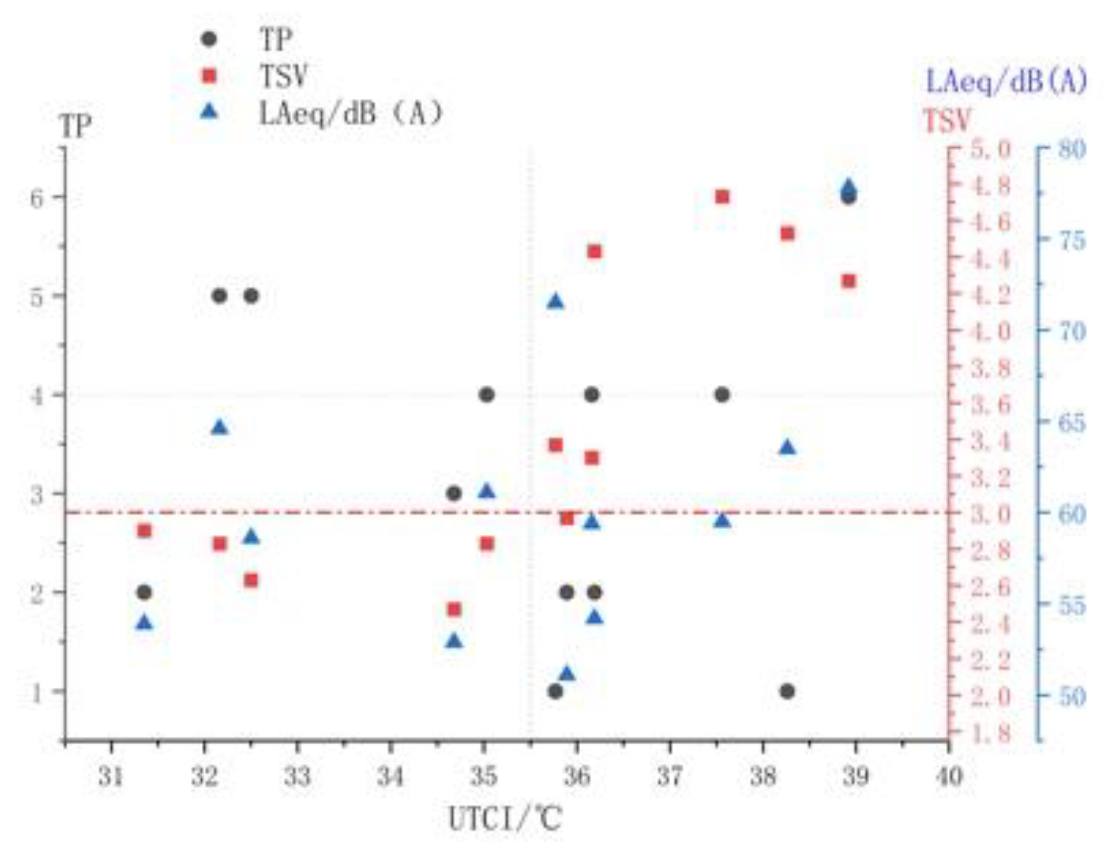
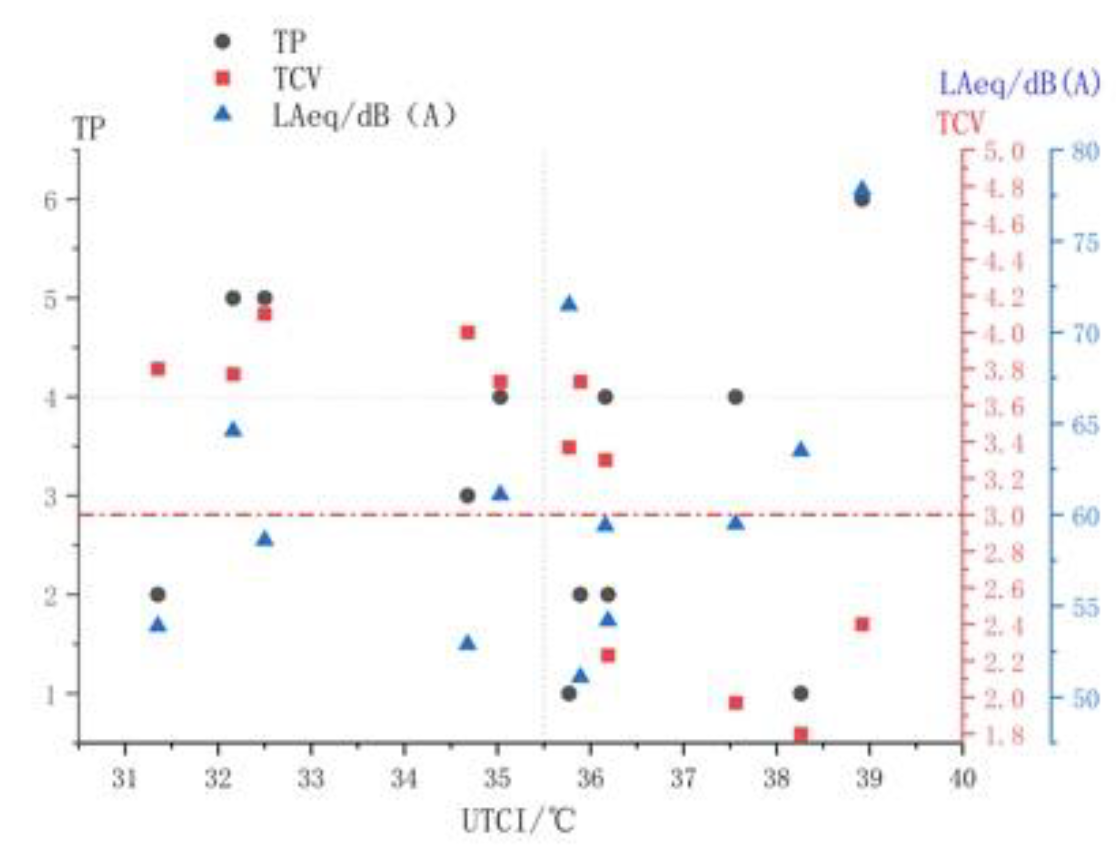

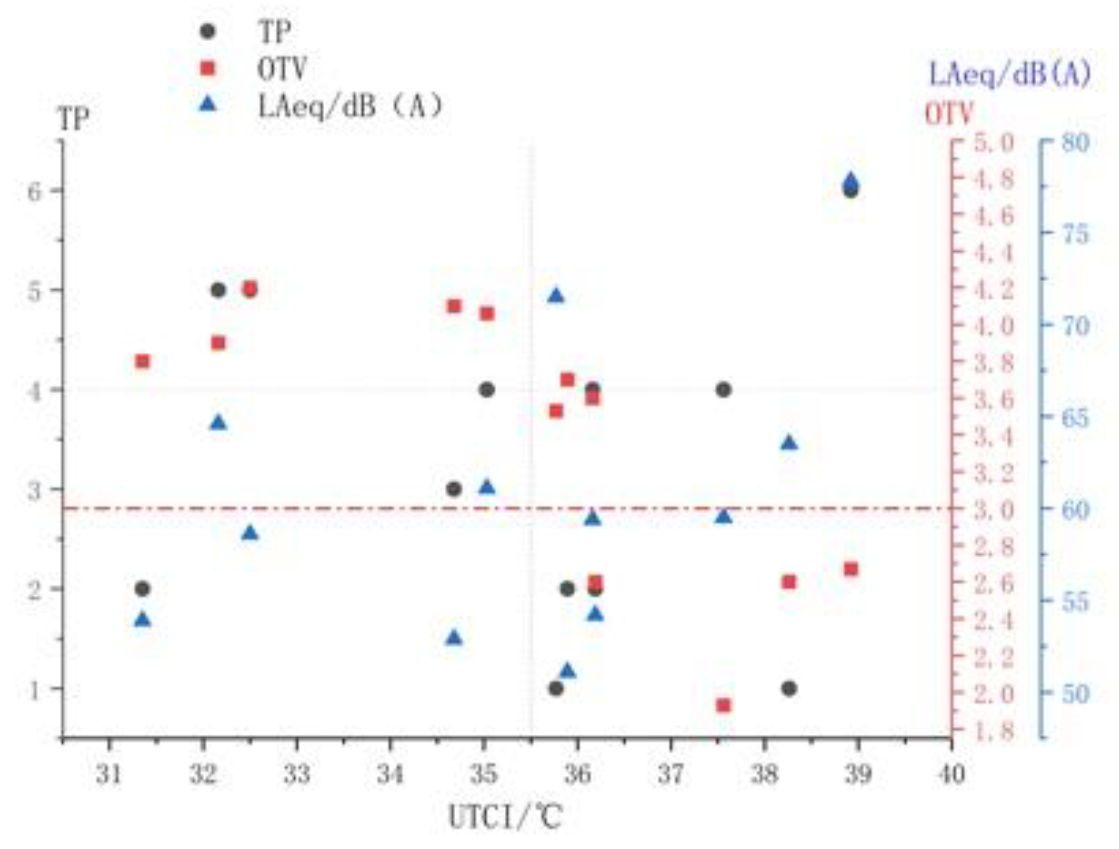

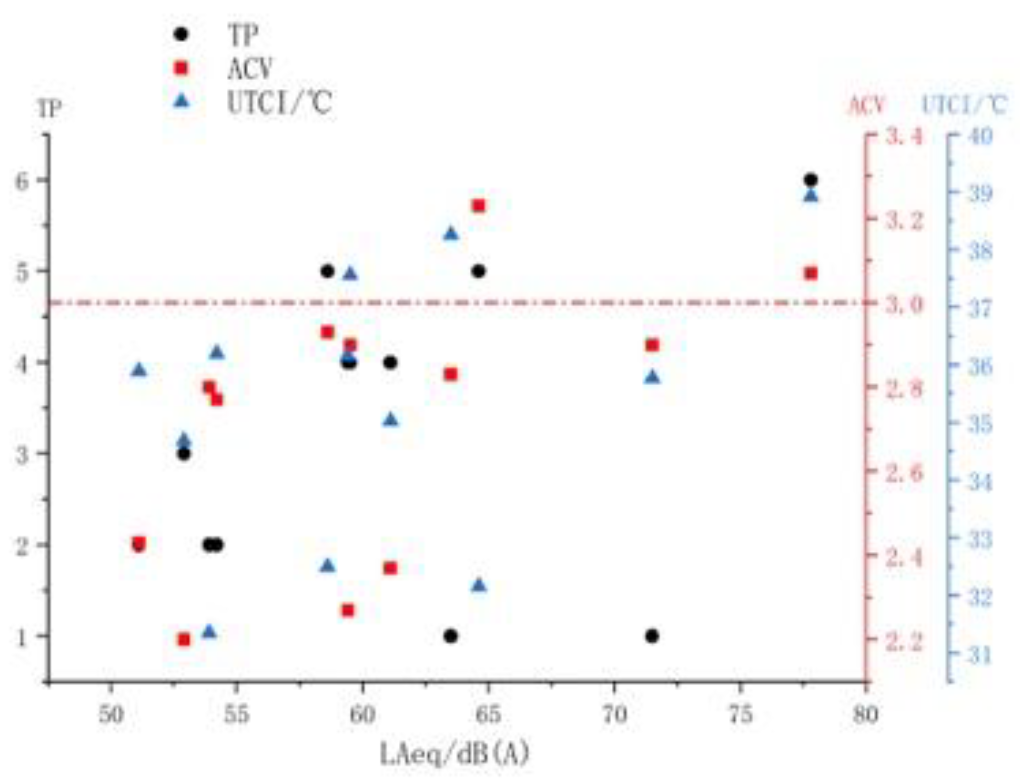

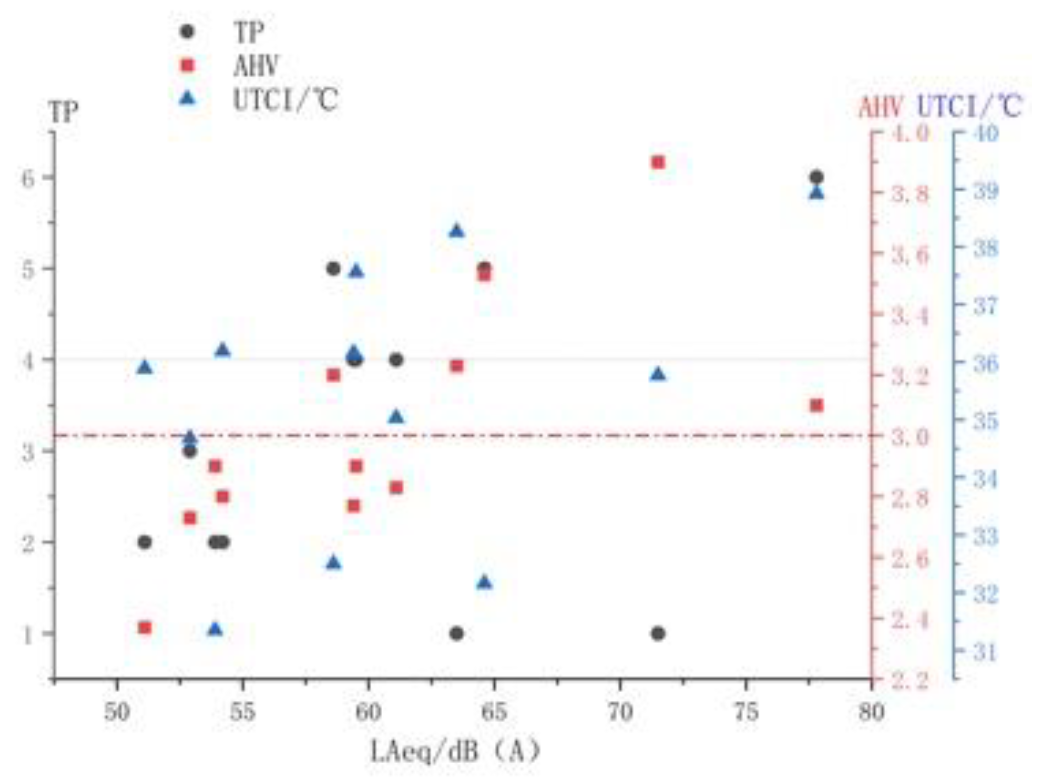
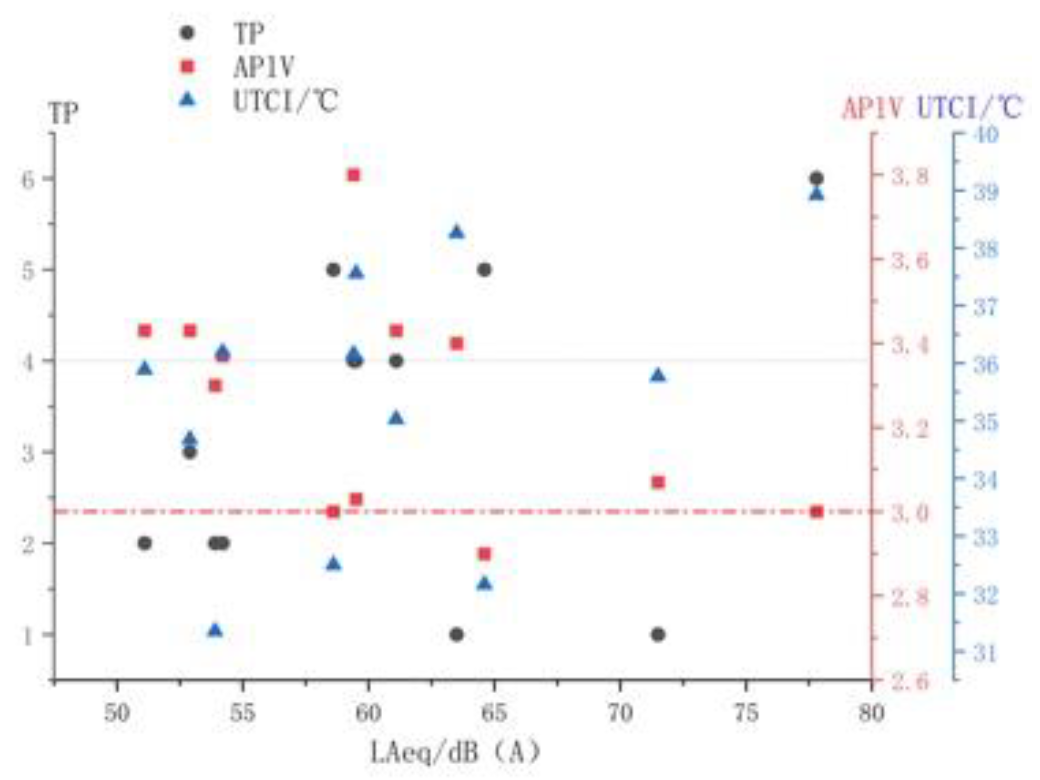
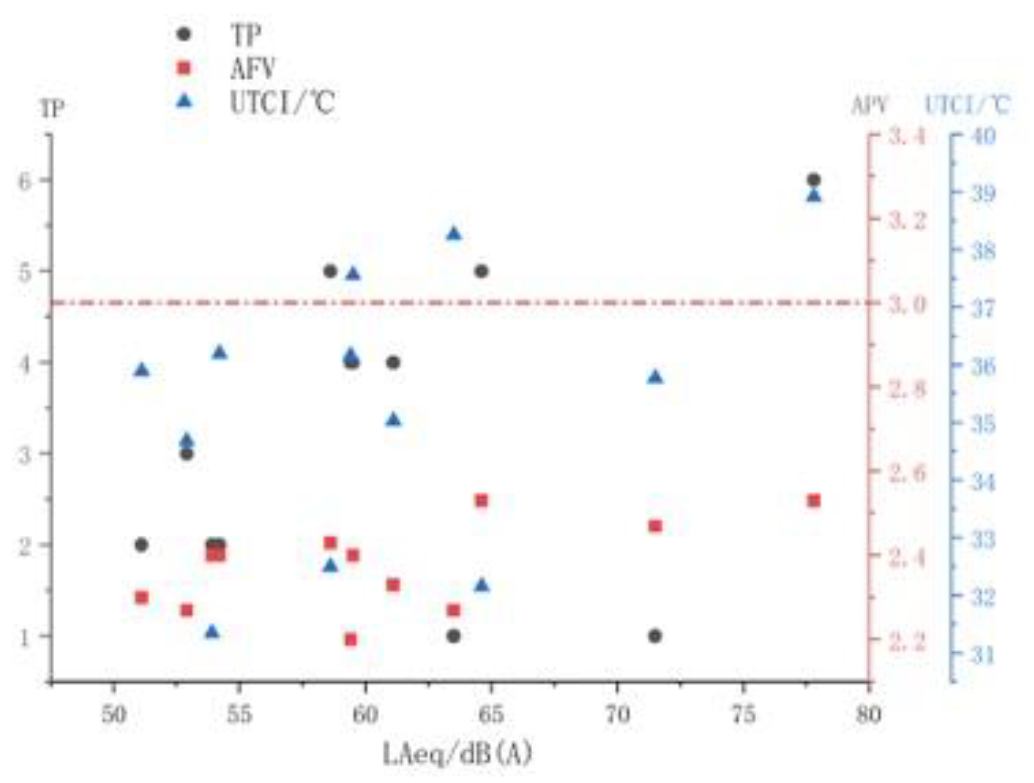

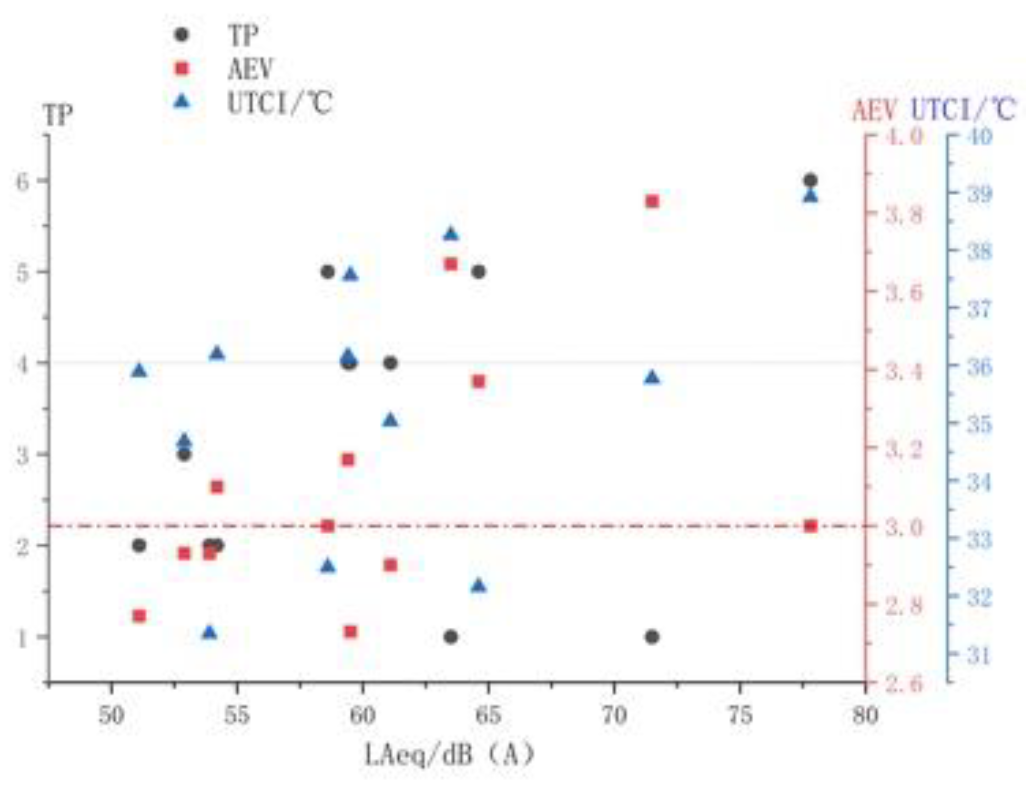
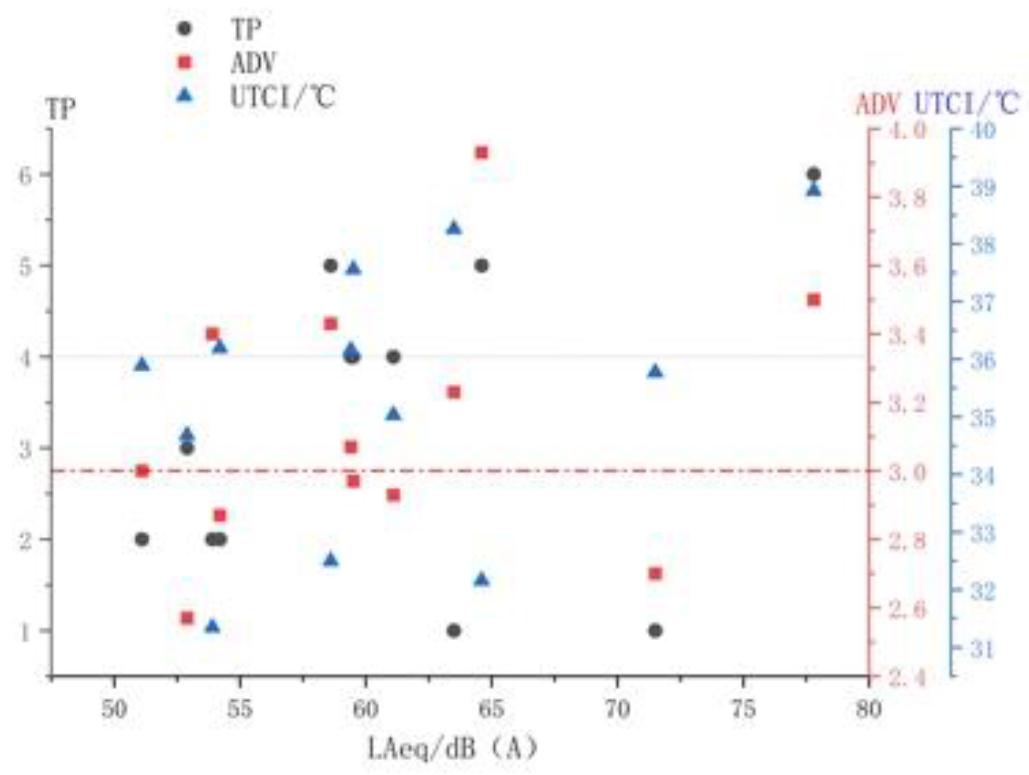

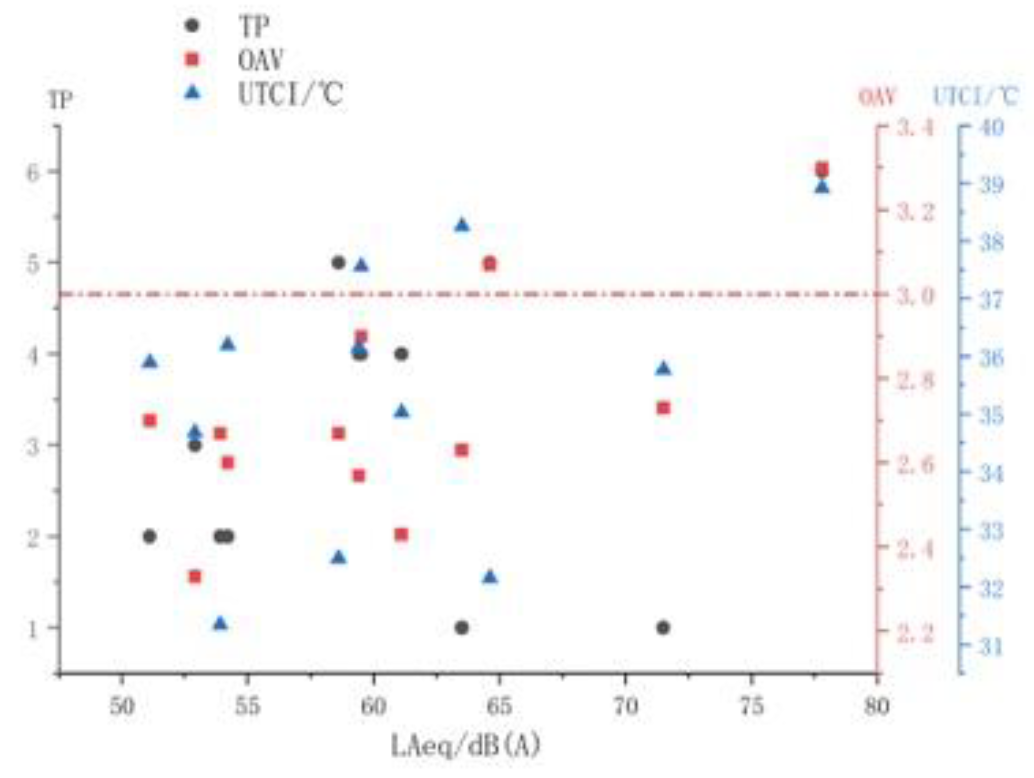

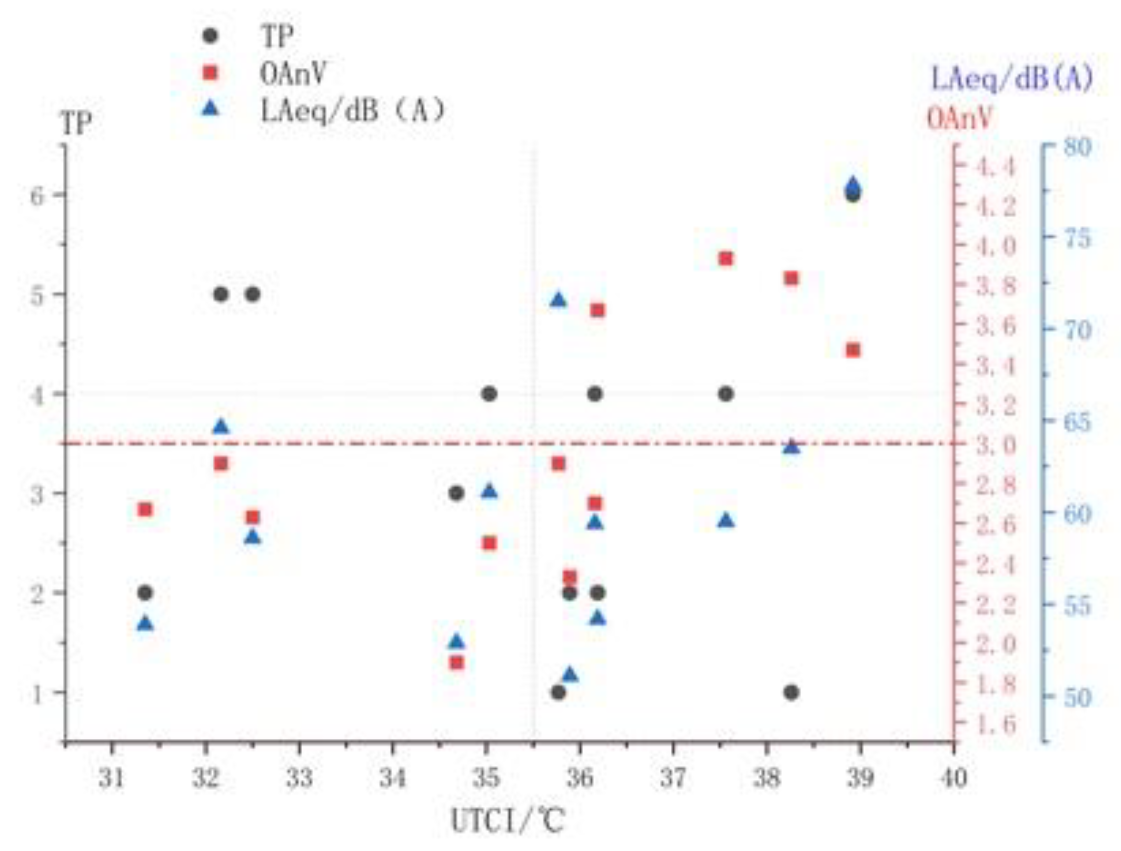
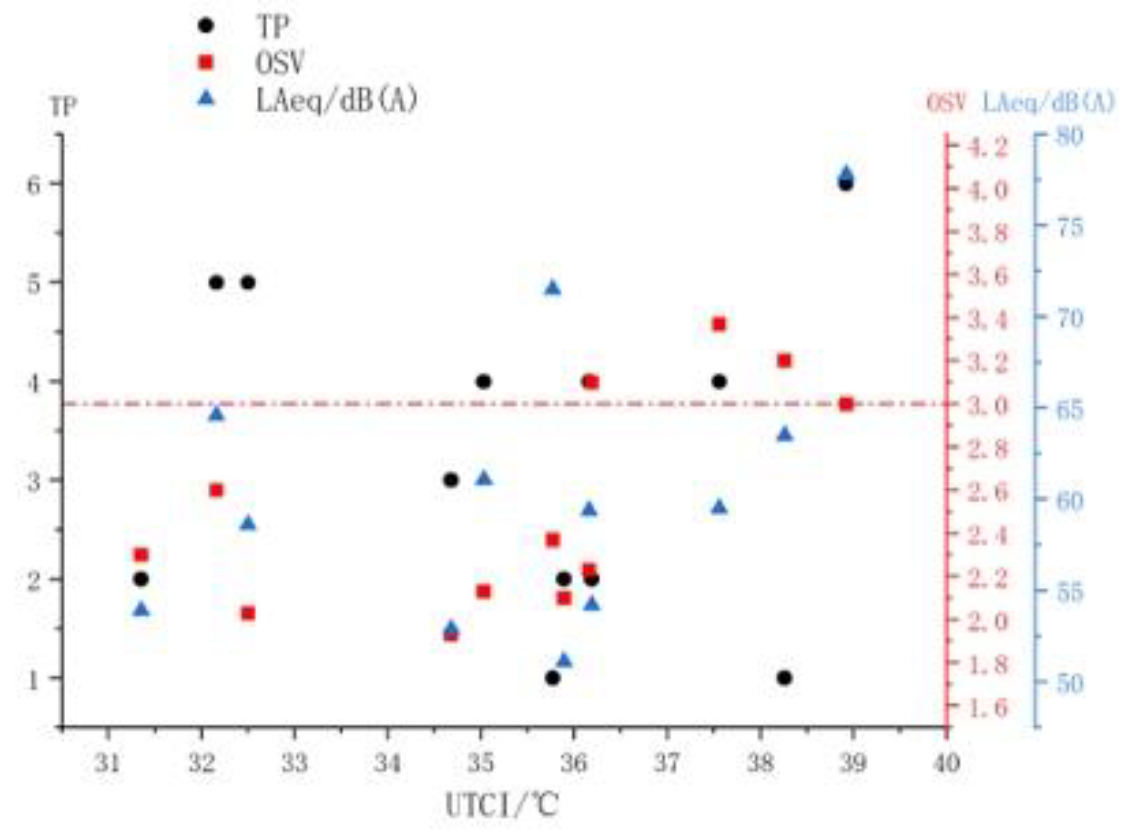
| Scores | Thermal Sensation | Thermal Comfort | Thermal Acceptance | Overall Thermal |
|---|---|---|---|---|
| 1 | Cold | Uncomfortable | unacceptable | Bad |
| 2 | cool | Slightly Uncomfortable | Slightly unacceptable | Slightly bad |
| 3 | Neutral | Neutral | Neutral | Neutral |
| 4 | warm | Slightly Comfortable | Slightly acceptable | Slightly good |
| 5 | Hot | Comfortable | acceptable | Good |
| Scores | Subjective Loudness | Acoustic Comfort | Acoustic Preference | Acoustic Harshness | Acoustic Pleasure | Acoustic Familiarity | Acoustic Intensity | Acoustic Excitability | Acoustic Disorder | Acoustic Coordination | Overall Acoustic |
|---|---|---|---|---|---|---|---|---|---|---|---|
| 1 | Quiet | Uncomfortable | Unlike | Gentle | Unhappy | Strange | Weak | Calm | Monotonous | Incoordinate | Bad |
| 2 | Slightly quiet | Slightly Uncomfortable | Slightly unlike | Slightly Gentle | Slightly Unhappy | Slightly Strange | Slightly weak | Slightly Calm | Slightly monotonous | Slightly incoordinate | Slightly bad |
| 3 | Neutral | Neutral | Neutral | Neutral | Neutral | Neutral | Neutral | Neutral | Neutral | Neutral | Neutral |
| 4 | Slightly Loud | Slightly Comfortable | Slightly like | Slightly harsh | Slightly happy | Slightly familiar | Slightly strong | Slightly excited | Slightly disordered | Slightly coordinate | Slightly good |
| 5 | Loud | Comfortable | Like | Harsh | Happy | Familiar | Strong | Excited | Disordered | Coordinate | Good |
| Scores | Overall Comfort | Overall Annoyance | Overall Satisfaction |
|---|---|---|---|
| 1 | Uncomfortable | Peaceful | Bad |
| 2 | Slightly Uncomfortable | Slightly Peaceful | Slightly bad |
| 3 | Neutral | Neutral | Neutral |
| 4 | Slightly Comfortable | Slightly annoying | Slightly good |
| 5 | Comfortable | annoying | Good |
| Type | Range | Precision |
|---|---|---|
| Kestrel 5500 | 0.4~40 m/s | ±0.1 m/s |
| weather station | ||
| BES-01 temperature | −30 °C~50 °C | ±0.5 °C |
| recorder | ||
| BES-02 temperature | −30 °C~50 °C | ±0.5 °C |
| And humidity recorder | 0%~99% RH | ±3% RH |
| BSWA801 noise | 19 dB(A)~137 dB(A) | <0.7dB (A) |
| vibration analyser |
| Plot | Ta (°C) | Ts (°C) | Humidity (%) | Va (m/s) | UTCI (°C) | LAeq (dB) | Source Type |
|---|---|---|---|---|---|---|---|
| 1 | 30.30 | 30.50 | 57.50 | 0.00 | 31.35 | 53.90 | 2 (bird song) |
| 2 | 31.10 | 31.20 | 54.40 | 0.40 | 32.16 | 64.60 | 5 (conversations) |
| 3 | 31.40 | 31.70 | 55.60 | 0.00 | 32.50 | 58.60 | 5 (conversations) |
| 4 | 31.60 | 31.80 | 70.10 | 0.20 | 34.68 | 52.90 | 3 (rustling leaves) |
| 5 | 32.00 | 33.10 | 68.20 | 0.00 | 35.03 | 61.10 | 4 (broadcasting music) |
| 6 | 31.90 | 32.80 | 73.10 | 0.10 | 35.77 | 71.50 | 1 (water) |
| 7 | 32.30 | 33.50 | 68.20 | 0.30 | 35.89 | 51.10 | 2 (bird song) |
| 8 | 32.60 | 33.50 | 68.10 | 0.30 | 36.16 | 59.40 | 4 (radio music) |
| 9 | 32.80 | 34.60 | 65.20 | 0.10 | 36.19 | 54.20 | 2 (bird song) |
| 10 | 33.80 | 35.50 | 62.60 | 0.80 | 37.56 | 59.50 | 4 (broadcasting music) |
| 11 | 34.10 | 36.20 | 65.70 | 0.10 | 38.26 | 63.50 | 1 (water) |
| 12 | 34.80 | 36.80 | 61.00 | 0.60 | 38.92 | 77.80 | 6 (Construction noise) |
| Subjective Evaluation | UTCI | LAeq | UTCI × LAeq | TP |
|---|---|---|---|---|
| TSV | 0.003 | 0.196 | 0.12 | 0 |
| TCV | 0.016 | 0.298 | 0.221 | 0.001 |
| TAV | 0.039 | 0.219 | 0.155 | 0.225 |
| OTV | 0.059 | 0.611 | 0.458 | 0.007 |
| Subjective Evaluation | UTCI | LAeq | UTCI × LAeq | TP |
|---|---|---|---|---|
| SLV | 0.133 | 0.007 | 0.034 | 0.12 |
| ACV | 0.209 | 0.129 | 0.133 | 0.001 |
| APV | 0.699 | 0.474 | 0.513 | 0.019 |
| AHV | 0.086 | 0.007 | 0.027 | 0.418 |
| APlV | 0.577 | 0.394 | 0.441 | 0.26 |
| AFV | 0.969 | 0.858 | 0.887 | 0.581 |
| AIV | 0.006 | 0 | 0.001 | 0.222 |
| AEV | 0.058 | 0.014 | 0.034 | 0.137 |
| ADV | 0.518 | 0.417 | 0.333 | 0.002 |
| ACoV | 0.093 | 0.135 | 0.147 | 0.042 |
| OAV | 0.724 | 0.748 | 0.739 | 0.082 |
| Subjective Evaluation | UTCI | LAeq | UTCI × LAeq | TP |
|---|---|---|---|---|
| OCV | 0.015 | 0.252 | 0.158 | 0 |
| OAnV | 0.004 | 0.026 | 0.018 | 0 |
| OSV | 0.02 | 0.11 | 0.086 | 0.003 |
Disclaimer/Publisher’s Note: The statements, opinions and data contained in all publications are solely those of the individual author(s) and contributor(s) and not of MDPI and/or the editor(s). MDPI and/or the editor(s) disclaim responsibility for any injury to people or property resulting from any ideas, methods, instructions or products referred to in the content. |
© 2023 by the authors. Licensee MDPI, Basel, Switzerland. This article is an open access article distributed under the terms and conditions of the Creative Commons Attribution (CC BY) license (https://creativecommons.org/licenses/by/4.0/).
Share and Cite
Chen, Y.; Liu, F.; Lin, X.; Liu, J.; Chen, Z.; Shi, K.; Li, J.; Dong, J. Combined Effects of the Thermal-Acoustic Environment on Subjective Evaluations in Urban Park Based on Sensory-Walking. Forests 2023, 14, 1161. https://doi.org/10.3390/f14061161
Chen Y, Liu F, Lin X, Liu J, Chen Z, Shi K, Li J, Dong J. Combined Effects of the Thermal-Acoustic Environment on Subjective Evaluations in Urban Park Based on Sensory-Walking. Forests. 2023; 14(6):1161. https://doi.org/10.3390/f14061161
Chicago/Turabian StyleChen, Ye, Fan Liu, Xinya Lin, Jing Liu, Ziyi Chen, Kailong Shi, Junyi Li, and Jianwen Dong. 2023. "Combined Effects of the Thermal-Acoustic Environment on Subjective Evaluations in Urban Park Based on Sensory-Walking" Forests 14, no. 6: 1161. https://doi.org/10.3390/f14061161
APA StyleChen, Y., Liu, F., Lin, X., Liu, J., Chen, Z., Shi, K., Li, J., & Dong, J. (2023). Combined Effects of the Thermal-Acoustic Environment on Subjective Evaluations in Urban Park Based on Sensory-Walking. Forests, 14(6), 1161. https://doi.org/10.3390/f14061161








